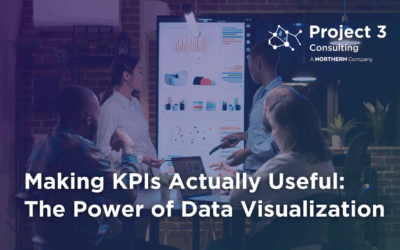
While undergoing a digital transformation, businesses face an array of challenges. These challenges encompass a wide range of hurdles: resistance to change, complexities of integrating digital solutions with legacy systems, safeguarding sensitive customer and company data, allocating the necessary budget, identifying and retaining staff with the right technical expertise, selecting the most suitable technologies and tools from a plethora of options, and ensuring that the chosen digital solutions can scale with business growth. Add in the task of actually quantifying the value of analytics in digital transformations… is your head spinning yet?
Defining and measuring success in digital transformation can be challenging, but it’s essential to justify the investments made. Making matters worse, all the above-mentioned challenges are amplified in organizations that are navigating reductions in force or struggling to secure quality technical talent. If you’re a marketing director or a digital transformation lead at a major organization grappling with these issues, first, know you’re not alone. That’s why we’re here – as your trusted partner helping you navigate the stormy seas of digital transformations. And it all starts with analytics.
The Business Value of Analytics
The strategic utilization of analytics is not just a competitive advantage; it’s a necessity. Analytics hold the key to unlocking the full potential of your business by driving data-driven decisions, improving customer segmentation, and enhancing personalized marketing campaigns.
Improved Customer Segmentation
Improved customer segmentation is a key benefit of using analytics in digital marketing. By effectively segmenting your customer base, you can target the right audience with the right message, leading to improved marketing results. For example, consider an e-commerce company that uses analytics to segment its customers. They analyze their digital data and find that a specific segment of their customer base consists of tech-savvy early adopters who prefer high-end electronics.
Let’s say our e-commerce company launches a specialized email marketing campaign promoting their latest cutting-edge electronic products to this segment. As a result, they see a significant increase in sales within this group, higher customer retention, and greater customer lifetime value. The quantifiable value here is the clear uptick in revenue and customer engagement within this refined segment.

Personalized Marketing Campaigns
Analytics enables organizations to create personalized marketing campaigns tailored to individual customer preferences and behavior. This leads to more engaging and effective marketing efforts. Consider a digital marketing agency running a pay-per-click (PPC) advertising campaign for a client. They use analytics to track the performance of different ad creatives, targeting options, and keywords.
Through continuous analysis, the agency identifies that a specific ad creative with a particular set of keywords performs exceptionally well for a certain audience segment. They allocate a larger portion of the campaign budget to this high-performing combination, resulting in improved click-through rates, conversion rates, and a higher ROI. The value here is evident through the campaign’s increased efficiency and more sales.
Improved Product Development
Analytics can provide valuable insights into customer preferences and market trends, which can be key insights for product development. A digitally minded organization can leverage these insights to create and refine products that resonate with their target audience.
For example, a software company uses analytics to monitor user interactions and feedback on their current products. They notice that customers frequently request a feature related to data visualization. Based on this data-driven insight, the company decides to invest in developing a new data visualization tool. After its launch, the product becomes a hit in the market, attracting new customers and increasing customer satisfaction scores. The quantifiable value is reflected in increased sales of the new product and higher customer satisfaction, as their product now aligns better with what their customers want.
Leveraging Analytics to Drive Digital Transformation
Now that we’ve established the importance of analytics, let’s consider how analytics can be leveraged to drive digital transformation:
Data-Driven Decision Making
Leveraging analytics for decision making is the cornerstone of a successful digital transformation. It goes beyond the adoption of new technologies; it’s about translating data into actionable insights. Analytics provides organizations with the capability to make informed, strategic decisions by deciphering patterns and trends within their data. This ability to make data-driven decisions is crucial for steering the transformation journey effectively.
Similar to how our e-commerce company above used analytics to segment its customers for marketing, organizations can use analytics to segment their transformation initiatives too. By analyzing historical data, they can make informed decisions about which technologies and methodologies to lean into and how to align their transformation efforts with evolving customer expectations.
Customer Insights
Analytics is a key piece of the puzzle in understanding customers, and this understanding is invaluable during digital transformation. By analyzing customer preferences and behaviors, organizations can personalize their transformation efforts, which ultimately leads to increased customer satisfaction and loyalty. Leveraging analytics for digital transformation means harnessing what you know about your customers to guide and shape the transformation journey.
In the context of digital transformation, just as personalized marketing campaigns use analytics to target specific audience segments, organizations can use customer insights to tailor their transformation initiatives. By aligning their strategies with customer preferences and expectations, they not only meet customer needs but also ensure that their digital transformation efforts result in satisfied and loyal customers.

Reporting and Optimization
For digital transformations to succeed, it’s essential to convert data into tangible results, much like optimizing marketing campaigns for maximum performance. Our consulting services extend to robust reporting and conversion rate optimization strategies, helping organizations turn data into meaningful, measurable business value during their digital transformation journey.
In this context, organizations can use analytics to monitor and measure the outcomes of their transformation initiatives. By setting clear KPIs and analyzing results, they can make data-driven decisions to adjust their strategies, optimize processes, and ensure that their digital transformation efforts are delivering the desired value and impact.
Some KPIs to consider:
- Customer Acquisition Cost (CAC): Analytics can help optimize marketing and sales efforts to reduce CAC.
- Customer Lifetime Value (CLV): Analytics can enhance customer segmentation and personalization, leading to higher CLV as customers remain engaged and loyal.
- Conversion Rate: Analytics can optimize conversion rates through data-driven insights.
- Churn Rate: Analytics can help identify factors leading to churn and strategies to reduce it.
- ROI (Return on Investment): Analytics can demonstrate the impact of the transformation efforts on the company’s bottom line.
- Customer Satisfaction (CSAT) and Net Promoter Score (NPS): Analytics can positively influence customer sentiment by providing insight into which personalized experiences can move the needle.
- Operational Efficiency Metrics: These might include cycle time, process efficiency, and cost reductions. Analytics can help identify areas for improvement and measure the impact of changes made during digital transformation.
- Digital Property Traffic and Engagement: Analytics can show increases in website and mobile app traffic, time spent on site, page views, and site interactions, reflecting improved online performance.
Operational Efficiency
Operational efficiency is at the core of any successful business transformation, and analytics is instrumental in identifying inefficiencies and bottlenecks. In the context of digital transformation, organizations can leverage analytics to streamline their transformation processes, identify and eliminate inefficiencies, and make data-driven decisions to enhance operational efficiency. Just as analytics results in increased sales through optimized marketing campaigns, it can be used to reduce costs and increase productivity during digital transformation, making the organization more competitive overall.
Digital Transformation with Project 3
Remember, successful digital transformation requires more than just technological adoption. It requires a data-driven approach and a partner with a clear understanding of the business value of analytics.
For organizations looking to enhance their digital transformation efforts and capitalize on analytics, we’re here to provide guidance and expertise. Digital transformations aren’t always a walk in the park, but making good use of analytics and partnering with experts like Project 3 can help smooth the path and make the journey a bit easier.




